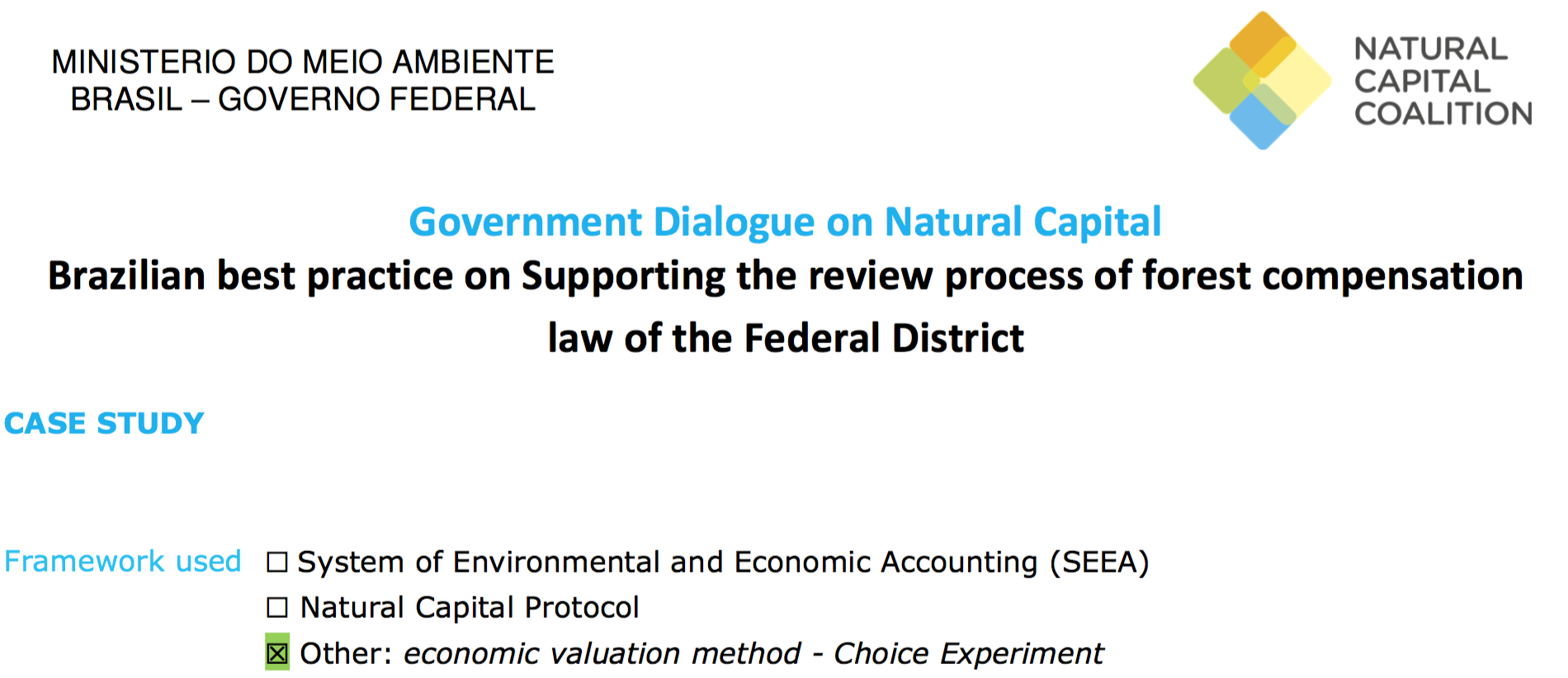The organization/ department in brief
The Secretary of Biodiversity from the Ministry of the Environment – MMA, supports the development of policies for the conservation and sustainable use of ecosystems, biodiversity and forests in Brazil, in an articulated and agreed manner with public actors and society for sustainable development in Brazil. Brazil and Germany have a history of cooperation of almost 50 years, in biodiversity conservation and sustainable use of ecosystems. Considering this scope, both countries joined together the project “Regional-Local TEEB Project: Biodiversity Conservation through the integration of Ecosystem Services into Public Policy and Business Action“, also known as TEEB Regional-Local, or TEEB R-L.
This project is jointly implemented by the Brazilian government, under the coordination of the Secretary of Biodiversity, of the Ministry of the Environment, and by the German government, though the German Federal Ministry for the Environment, Nature Conservation and Nuclear Safety (BMU), applying funds from the International Climate Initiative (IKI) and through its cooperation agency, Deutsche Gesellschaft für Internationale Zusammenarbeit (GIZ) GmbH.
The Project started in 2012, and the main objective was to foster biodiversity and ecosystem consideration in public policies planning and decision making. To accomplish this, project focused in activities to strengthen the dialogue between public and private actors, and activities focused on the development and implementation of study cases at local and regional levels to provide knowledge and models to influence broader scales decision making. Strategic processes (e.g. policies, plans, programs, instruments) at regional and local levels, that could contribute with innovative approaches in the valuation and conservation of biodiversity and ecosystem services, and that could produce information for decision-making were selected and used as demonstrative cases for broader scales and national policies.
The Regional-Local TEEB Project was originally scheduled to run until October 2016 but was extended until May 2019 through the inclusion of a new component, the support of the Brazilian government to the development of environmental economic accounts. More info here.
Why was this undertaken?
The Forest Compensation Law in the Federal District is the compensation paid by the entrepreneur for significant environmental impacts caused to the environment associated with the suppression of trees (to make roads, dwellings or for agricultural production). Forest compensation normative in the Federal District is related to the Decree No. 1483/1993 (modified in part by Decree No. 23.510 / 2002), and requires that the entrepreneur pays for the planting of 30 native trees for each tree cut-down. In the case of exotic trees, 10 new ones are required.
One weakness in this instrument is the lack of guarantees that ecological compensation will actually occur, since the area used for compensation is not required to have the same ecosystem services and biodiversity as the areas that were deforested. In addition, it is very costly to entrepreneurs. Therefore, to improve the environmental benefits of this instrument, the Regional-Local TEEB Project supported the Federal District Environment Secretariat between 2015 and 2017 in the process of revision of the Forest Compensation Law, aiming to improve it using the ecosystem services approach.
What was the scope?
The new proposal for forest compensation policy includes two changes:
(1) The possibility of compensating the suppression of trees not only through restoration, as previously, but also through the conservation of areas of native vegetation;
(2) The use of variable compensation rates, which vary according to the ecological qualities of the suppressed and compensated areas depending on some factors: soil conservation status; the proportion of invasive species; the relationship with water resources; and the rarity of vegetation structure and composition.
To ensure that the total deforested area was ecologically equivalent to the restored or conserved area, the Regional-Local TEEB Project supported a study, conducted by Conservation Strategy Fund, which calculated the relative amounts (weights) of the ecological criteria used for the definition of such compensation rates. These weights were collected in a workshop with experts of the Cerrado’s biome. This survey was based on an economic valuation method called the Choice Experiment, where scenarios formed by ecological criteria in different configurations were compared in sets of choice, in which each expert of the experiment pointed out the alternative that would be more important to be preserved or recovered. The responses were statistically interpreted to generate the criteria weights, resulting from a total of 600 scenario comparisons. Weights were calculated separately for “conservation priority” and “restoration priority” – unlike conservation priority, environmental quality is negatively related to restoration priority (areas with poor quality have greater potential for ecological gain).
What was the role of the Government?
The Ministry of the Environment, through the Regional-Local TEEB Project, supported the Federal District Environment Secretariat and the Cerrado Alliance, which requested support in improving the environmental compensation law. The Local Government participated in the whole process and has the function of approving and implementing the changes in the state legislation.
What were the results?
The main result was the suggestion of a new policy with the possibility to compensate the suppression of trees not only by restoration, but also by the conservation of native vegetation areas and the use of variable compensation rates.
The comparative analysis of different relative weights and proxies related to ecological criteria in the definition of compensation rates showed that, for both “conservation priority” and “priority for restoration”, soil status is the criteria of greatest weight – in function of the importance of the soil for the support of other ecosystem services. The proportion between native vegetation and exotic species and the proximity to water resources appear in sequence, with different magnitudes for conservation and restoration. Based on the results, it was possible for the Regional-Local TEEB Project results to deliver a hierarchical list with priority areas ordering for restoration and conservation according to the combinations of the ecological characteristics, allowing even the comparison of the gains in avoiding the deforestation of areas conserved with the gain restore degraded areas.
Given the established standards of ecological benefits, the entrepreneurs can make a cost-benefit analysis comparing various areas and technologies of possible restoration and conservation to minimize their costs. Thus, as the availability of feasible areas and possible technologies to be applied vary, optimum solutions for entrepreneurs are also expected to change. From the economic point of view, the study showed that the cost of this new policy for landowners is lower and is likely to generate real environmental gains.
The Regional-Local TEEB Project has contributed to the formulation of innovative public policy, that can promote environmental gains, while reducing economic costs and encourages the use of areas of good ecological quality for compensation through conservation and use of areas for restoration/ compensation. This type of policy actually represents an incentive for the productive sectors to become environmentally regular with cost reduction, while maximizing environmental gains – a win-win situation for conservation and for the productive sector.
Next steps
As recommendations for future studies, it is possible to enhance the criteria used in the model, discussing, from these results, the levels of the considered attributes, as well as the inclusion or not of other criteria. The impacts of different multipliers on the dynamics of land use should also be studied, as these can be used to act as a tool to reach biodiversity conservation goals. For this, a specialized analysis of the opportunity costs of the land is also necessary, to predict land use patterns and the potential of the compensation markets in the Brazilian states.
The example of the Federal District opens possibilities for improvement and replication in the Cerrado biome. Starting from the results on the levels of ecological equivalence, social and economic criteria can also be combined for the refinement of economic ecological zoning policies, as well as for the definition of incentives on priority areas for biodiversity and ecosystem services.
The use of a robust formula that maintains environmental equity is a mechanism that allows actors to be clear about the costs and benefits of their choices, internalizing in their decisions environmental aspects that would otherwise be ignored. Thus, it allows the market to be able to generate more efficient decisions from the environmental point of view, through a flexible instrument capable of also minimizing the economic costs for the agents involved.













